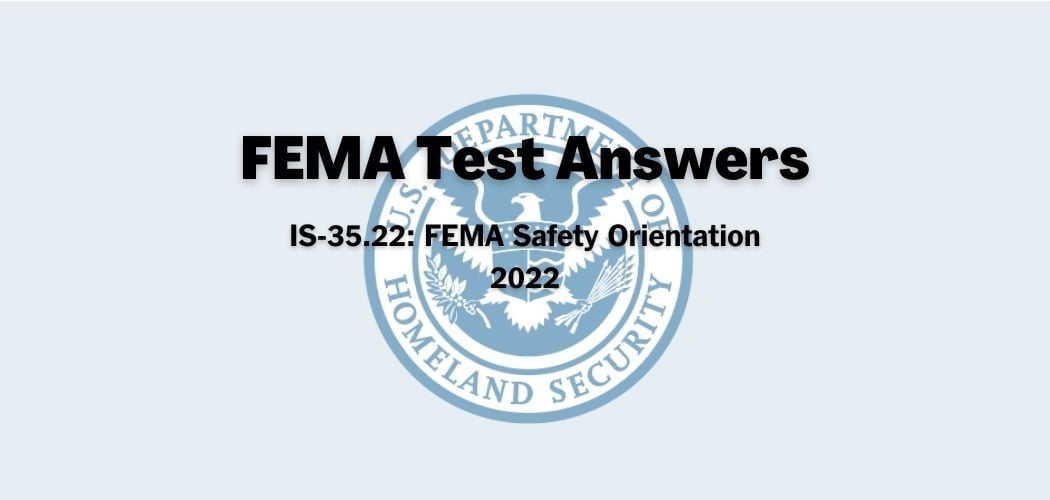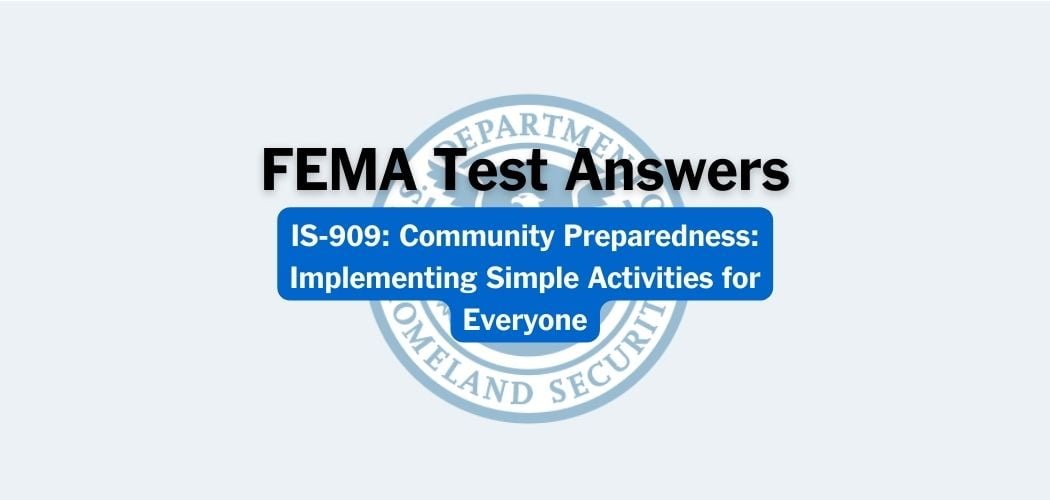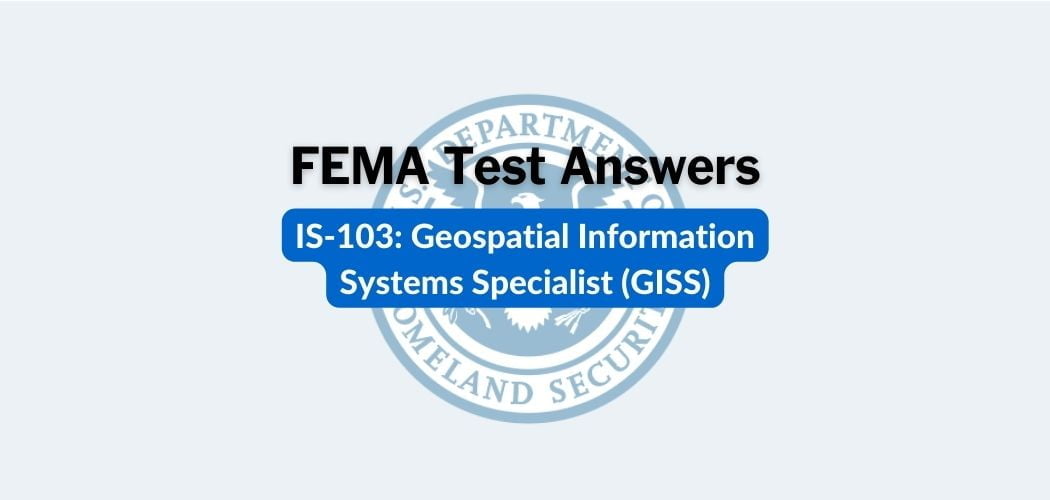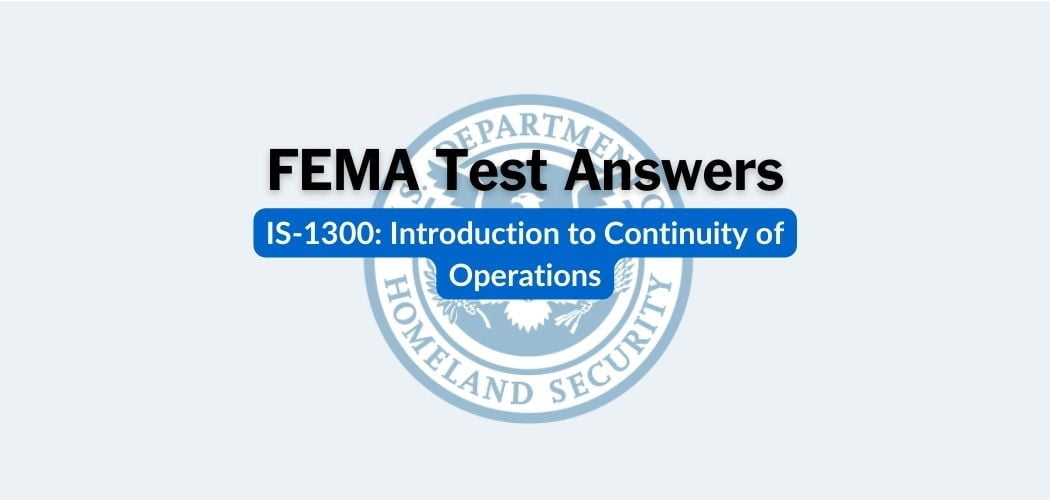Overview: The FEMA IS-822 course was published on 11/27/2013 to provide the fundamental knowledge for Federal Emergency Management Agency (FEMA) and other Federal emergency management personnel to assist with disaster operations with incident management or support roles.
The course content is based on FEMA’s authorities and doctrine. This awareness level course provides the learner a good starting point to further training in his/her specific FQS position.
Primary audience: FEMA IS-822 is for all FEMA employees who are assigned to a FEMA Qualification System (FQS) position in incident management or incident support.
Prerequisites
- IS-100: Introduction to the Incident Command System, ICS 100
- IS-101: Preparing for Federal Disaster Operations: FEMA
- IS-200: Basic Incident Command System for Initial Response
- IS-700: An Introduction to the National Incident Management System
- IS-800: National Response Framework, An Introduction
FEMA IS-822 test answers
Each time this test is loaded, you will receive a unique set of questions and answers. The test questions are scrambled to protect the integrity of the exam.
Question 1. All of the following are examples of deliberate planning products EXCEPT:
A. Power Restoration Plan due to hurricane damage✅
B. Regional Catastrophic Plan
C. National Hurricane Concept of Operations Plan
D. Improvised Nuclear Device Concept Plan
Question 2. Which of the following is the best description of resource typing?
A. The assignment of resources to the appropriate branch in the Operations Section
B. The use of criteria that ensure consistent training, licensure, and certification standards
C. The categorization of resources by kind and capability✅
D. Using mutual aid to acquire resources
Question 3. Which of the following statements best describes the National Incident Support Manual (NISM)?
A. It establishes a new functional organizational structure within the Regional Response Coordination Center (RRCC).
B. It defines tasks to be accomplished for incident support versus incident management.
C. It describes how FEMA national staff supports FEMA incident operations.✅
D. It identifies the support provided by mutual aid
Question 4. The Regional Response Coordination Center (RRCC) and the National Response Coordination Center (NRCC) have been activated. This is an example of what type of activity?
A. Authorized pre-declaration activity
B. Public assistance
C. Fire management assistance
D. Incident management✅
Question 5. By determination of the President, Federal assistance is provided to supplement State and local efforts and capabilities to save lives and protect property, public health, and safety. Which type of declaration does this describe?
A. State of Emergency
B. Catastrophes
C. Emergency✅
D. Public assistance
Question 6. Which section has the responsibility for establishing situational control at the incident level?
A. Logistics Section
B. Finance/Administration Section
C. Planning Section
D. Operations Section✅
Question 7. Which legal authority modified the Homeland Security Act (HSA) with respect to the organizational structure, authorities, and responsibilities of FEMA and the FEMA Administrator and made FEMA a distinct entity within the Department of Homeland Security (DHS)?
A. Homeland Security Presidential Directive 5 (HSPD 5)
B. Stafford Act
C. Post-Katrina Emergency Management Reform Act (PKEMRA)✅
D. Presidential Policy Directive-8 (PPD-8)
Question 8. How did the Sandy Recovery Improvement Act (SRIA) of 2013 amend the Stafford Act?
A. It authorized the President to add to the list of Federally-recognized tribes.
B. It authorized Congress to provide public assistance funding during a disaster.
C. It authorized local governments to sue FEMA for additional assistance in a crisis situation.
D. It authorized Federally Recognized tribal governments to directly request a declaration of an emergency or major disaster.✅
Question 9. True or False. For a multi-state catastrophic incident, there could be multiple concurrent incident action planning processes taking place.
A. TRUE✅
B. FALSE
Question 10. True or False. FEMA is typically the first source of Individual Assistance (IA) to disaster survivors.
A. TRUE
B. FALSE✅
Question 11. Which of the following statements best describes the Incident Management Handbook (IMH)?
A. It serves as a program reference guide.
B. It replaces National Incident Management System (NIMS) qualifications for those FEMA personnel who have Position Task Books.
C. It provides directions for FEMA personnel on all FEMA programs.
D. It forms the basis from which FEMA personnel will execute their assigned disaster response missions in the field.✅
Question 12. From the Joint Field Office (JFO), who coordinates with State, local, tribal, and territorial governments, private sector organizations, and non-governmental organizations (NGOs) to conduct response and recovery operations?
A. Regional Administrator (RA)
B. Director of Disaster Operations (DDO)
C. Federal Coordinating Officer (FCO)✅
D. Chief of the Regional Response Coordination Staff (RRCS)
Question 13. Which statement best describes the Emergency Management Assistance Compact (EMAC)?
A. Through EMAC, a state may request assistance from other states.✅
B. The National Response Framework (NRF) requires the use of EMAC.
C. FEMA is a charter member of EMAC.
D. When using EMAC, states are exempt from following the standards outlined in the National Incident Management System (NIMS).
Question 14. The Disaster Survivor Assistance Teams (DSAT) perform the “AIR” mission. What does AIR stand for?
A. Assess, Inform, Report✅
B. Assist, Inform, Repeat
C. Affirm, Integrate, Report
D. Analyze, Individual, Request
Question 15. Which legal authority directed the establishment of a single, comprehensive National Incident Management System (NIMS) that covers the prevention of, preparation for, response to, and recovery from terrorist attacks, major disasters, and other emergencies?
A. Homeland Security Presidential Directive 5 (HSPD 5)✅
B. Stafford Act
C. Post-Katrina Emergency Management Reform Act (PKEMRA)
D. Presidential Policy Directive-8 (PPD-8)
Question 16. What is the first step in the resource management process?
A. Track and report
B. Mobilize
C. Identify requirements✅
D. Order and acquire
Question 17. Which group of incident management staff demonstrates the NIMS principle of unified command/coordination?
A. National Response Coordination Staff (NRCS)
B. Regional Response Coordination Staff (RRCS)
C. Unified Coordination Group (UCG)✅
D. FEMA Response Directorate
Question 18. What are FEMA’s core values, as defined in FEMA Publication 1?
A. Security, fairness, integrity, and respect
B. Compassion, equality, integrity, and respect
C. Compassion, fairness, integrity, and respect✅
D. Security, equality, and integrity
Question 19. Which of the following is engaged in FEMA’s incident support?
A. State Emergency Operations Center (EOC)
B. Joint Field Office (JFO)
C. Regional Response Coordination Center (RRCC)✅
D. Initial Operating Facility (IOF)
Question 20. Which of the following statements best describes the National Incident Management System (NIMS)?
A. It describes specific authorities and best practices for managing incidents.
B. It is a guide to promote effective recovery, particularly for those incidents that are large-scale or catastrophic.
C. It provides a consistent, flexible, and adjustable national template within which government and private entities can work together to manage domestic incidents.✅
D. It calls for development and maintenance of a National Preparedness Goal.
Question 21. Which of the following is NOT true about Disaster Recovery Centers (DRCs)?
A. DRCs are operated solely by FEMA.✅
B. DRCs provide assistance with Small Business Administration (SBA) applications.
C. DRCs are often established in schools or armories.
D. DRCs serve as the “face” of FEMA to disaster survivors.
Question 22. Which legal authority enabled the President to direct pre-declaration activities by the Federal government?
A. Homeland Security Presidential Directive 5 (HSPD 5)
B. Stafford Act✅
C. Emergency Management Assistance Compact (EMAC)
D. Presidential Policy Directive-8 (PPD-8)
Question 23. Which of the following is NOT a type of Federal Stafford Act declaration?
A. Major disasters
B. Fire management assistance
C. Catastrophe✅
D. Emergency
Question 24. FEMA’s Incident Management and Support Keystone (IMSK) differentiates between incident support and incident management. Which of the following statements about incident support and incident management is NOT true?
A. Incident management is the incident-level operation of the Federal role in emergency response, recovery, logistics, and mitigation.
B. Incident management includes the direct control and deployment of resources, management of incident offices, operations, and delivery of Federal assistance through all phases of emergency response.
C. Incident support is the coordination of all Federal resources that support emergency response, recovery, logistics, and mitigation at the National Response Coordination Center (NRCC) and Regional Response Coordination Center (RRCC).
D. Incident support facilities include the Joint Field Office (JFO) and Initial Operating Facility (IOF).✅
Question 25. Which of the following is a temporary facility from which the IMAT first manages incident-level operations?
A. State Emergency Operations Center (EOC)
B. Initial Operating Facility (IOF)✅
C. Regional Response Coordination Center (RRCC)
D. Joint Field Office (JFO)



